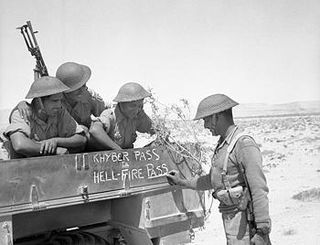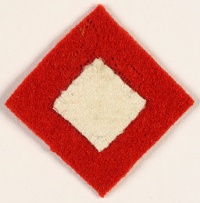| 6th Support Group | |
|---|---|
 6th Support Group insignia | |
| Active | 1940 - 1942 |
| Country | |
| Branch | British Army |
| Type | Artillery and Infantry |
| Role | Support Group |
| Size | Brigade |
| Part of | 6th Armoured Division |
| Insignia | |
| Insignia | Mailed Fist |
| 6th Support Group | |
|---|---|
 6th Support Group insignia | |
| Active | 1940 - 1942 |
| Country | |
| Branch | British Army |
| Type | Artillery and Infantry |
| Role | Support Group |
| Size | Brigade |
| Part of | 6th Armoured Division |
| Insignia | |
| Insignia | Mailed Fist |
This was a brigade sized formation of the British Army attached to the 6th Armoured Division.
In the early days of the Second World War the support group (or Pivot Group as it was sometimes known) was what its name suggested. It provided whatever support the armoured brigades needed to the operation in hand, being able to provide motorised infantry, field artillery, anti-tank artillery or light anti-aircraft artillery as needed. [1]

Operation Compass was the first large British military operation of the Western Desert Campaign (1940–1943) during the Second World War. British, Indian, Commonwealth and Allied forces attacked Italian forces of the 10th Army in western Egypt and Cyrenaica, the eastern province of Libya, from December 1940 to February 1941.

Operation Battleaxe was a British Army offensive during the Second World War to raise the Siege of Tobruk and re-capture eastern Cyrenaica from German and Italian forces. It was the first time during the war that a significant German force fought on the defensive. The British lost over half of their tanks on the first day and only one of three attacks succeeded.

The 1st Division, formerly known as the 1st Armoured Division, is a division of the British Army. It has recently returned home from being stationed in Germany. Originally formed in November 1937 as the Mobile Division, it saw extensive service during the Second World War and was disbanded afterwards; reconstituted in 1976, it remains in service. It should not be confused with the 1st Infantry Division.

The 11th Armoured Division was an armoured division of the British Army which was created in March 1941 during the Second World War. The division was formed in response to the unanticipated success of the German panzer divisions. The 11th Armoured was responsible for several major victories in the Battle of Normandy from in the summer of 1944, shortly after the D-Day landings of 6 June 1944, and it participated in the rapid advance across France, Belgium, and the Netherlands and, later, the Rhine crossing in March 1945, and later invaded Germany. It was disbanded in January 1946 and reformed towards the end of 1950. In 1956, it was converted into the 4th Infantry Division.

The 8th Armoured Division was an armoured division of the British Army during the Second World War. It was deployed to Egypt in June 1942 but never operated as a complete formation and was disbanded in January the following year.

The 9th Armoured Division was an armoured division of the British Army, raised during the Second World War. It never saw active service during the war as a complete division.

The 42nd Armoured Division was an armoured division of the British Army raised during the Second World War.
The 1st Armoured Brigade, raised as the 1st Light Armoured, later the 1st Armoured Brigade Group, was an armoured formation of the British Army.
The Second Battle of El Alamein order of battle is a listing of the significant formations that were involved in the Second Battle of El Alamein during the Western Desert Campaign of the Second World War, 23 October – 4 November 1942.

The Northumberland Hussars was a Yeomanry regiment of the British Army, transferred to the Royal Artillery for the duration the Second World War. It was disbanded as an independent Territorial Army unit in 1967, a time when the strength of the Territorial Army was greatly reduced. The regiment's name lives on in the title of the command and support squadron of the Queen's Own Yeomanry (QOY), a Formation Reconnaissance Regiment based in Newcastle upon Tyne.

The 7th Support Group was a supporting formation within the British 7th Armoured Division, active during the Second World War's Western Desert Campaign.
The 8th Support Group was a brigade-sized military formation of the British Army during the Second World War, attached to the 8th Armoured Division, composed of Regular Army units. The Support Group as part of 8th Armoured Division was sent to North Africa but never saw active service as a complete formation. As the division could not be provided with a lorried infantry brigade, it was broken up and was finally disbanded in Egypt on 1 January 1943.
This is the order of battle for Operation Goodwood, a World War II battle between British and German forces in Normandy, France between 18 July and 20 July 1944.
This is the order of battle for the ground forces involved in Operation Crusader, a World War II battle between the British Commonwealth and the European Axis Powers of Germany and Italy in North Africa between 18 November – 30 December 1941.

The Guards Support Group was a brigade size formation within the British Guards Armoured Division. The Support Group provided whatever support the division's armoured brigades needed for the operation in hand. It was able to provide motorised infantry, field artillery, anti-tank artillery or light anti-aircraft artillery as needed. It was formed in 1941 by the conversion of the 7th Infantry Brigade (Guards) which had served in the Battle of France, and disbanded in 1942 when it was converted into Headquarters, Royal Artillery, for Guards Armoured Division.
This article supplements the 7th Armoured Division article by providing order of battle information for the division through various periods of the Second World War as the organization of an armoured division was changed by the War Office. Due to the experience gained in the Middle East these changes were sometimes present in the armoured divisions there before the War Office mandated organization. Parallel changes were made in the organization in the armoured brigades. The Division frequently did not match any organization scheme due to the lack of units in the Middle East.
The British Armoured formations of World War II refers to the armoured divisions and independent armoured and tank brigades deployed by the British Army during the Second World War.

The 34th Armoured Brigade was an armoured brigade of the British Army that saw active service in the Second World War. It was formed in 1941 as the 34th Army Tank Brigade and subsequently redesignated as the 34th Tank Brigade in February 1945 and became part of the 79th Armoured Division. It was equipped with Churchill tanks and provided close support for assaults by the infantry. During the fighting in North-west Europe from July 1944 to May 1945 the brigade served with both the First Canadian Army and the British Second Army. The brigade was disbanded in early 1946.